Influence of Oxy-Fuel Lance Parameters on the Scrap Pre-Heating Temperature in the Hot Metal Ladle
Abstract
:1. Introduction
2. Mathematical Model
2.1. Flow Field for Hot Metal Ladle
2.2. Combustion Model
2.3. Porous Media Model
2.4. Radiation Model
3. Calculation Methods and Conditions
3.1. Introduction of the Scrap Pre-Heating Process for the Hot Metal Ladle
3.2. Physical Modeling and Meshing
3.3. Boundary Conditions and Solution Process
3.4. Model Validation
4. Results and Discussion
4.1. The Effect of the Gas Flow Rate on Scrap Pre-heating Temperature
4.1.1. Flow Field of Hot Metal Ladle
4.1.2. Temperature Field of Hot Metal Ladle
4.1.3. The Effect of Gas Flow Rate on the Average Scrap Pre-Heating Temperature
4.1.4. Variation in Scrap Temperature at Different Locations
4.2. The Effect of the Lance Position on Scrap Pre-Heating Temperature
4.2.1. Flow Field of Hot Metal Ladle
4.2.2. Temperature Field of Hot Metal Ladle
4.2.3. The Effect of the Lance Position on the Average Scrap Pre-Heating Temperature
4.2.4. Variation in Scrap Temperature at Different Locations
4.3. The Effect of the Nozzle Angle on Scrap Pre-Heating Temperature
4.3.1. Flow Field of Hot Metal Ladle
4.3.2. Temperature Field of Hot Metal Ladle
4.3.3. The Effect of the Nozzle Angle on the Average Scrap Pre-Heating Temperature
4.3.4. Variation in Scrap Temperature at Different Locations
5. Conclusions
- (1)
- The rational and correct selection of the gas flow rate has an essential influence on the temperature field, the average temperature in the scrap area. When the gas flow rate increases, the internal annular combustion zone of the scrap gradually expands, the cold zone at the bottom of the scrap continues to reduce, and the average temperature of the scrap keeps increasing. When the gas flow rate is 5000 m3/h, the annular combustion zone is more evenly distributed, the cold zone is more reasonably distributed, and the pre-heating temperature reaches 1197 K in 9.98 min;
- (2)
- When the oxy-fuel lance position is lowered, the gas circulation zone is reduced, and there is no obvious pattern of change in the internal annular combustion zone of the scrap. When the lance position is 1378 mm, the temperature field in the scrap area is more evenly distributed, which is more advantageous in improving the bottom scrap cooling zone and increasing the average temperature in the scrap cooling zone;
- (3)
- When the nozzle angle increases, the range of the gas circulation zone is reduced, the temperature of the “X” type combustion zone inside the scrap is obviously reduced, the temperature difference between the bottom axis of the scrap and the surrounding area continues to expand, and the reasonable choice of the nozzle angle is conducive to improving the uniformity of the flow field. When the nozzle angle is 15°, the gas circulation zone is the largest, the temperature distribution in the internal combustion zone of the scrap is better, and the average temperature of the scrap pre-heating reaches 1197 K in the shortest time.
Author Contributions
Funding
Data Availability Statement
Conflicts of Interest
References
- Jia, Y.Q.; Duan, H.M.; Liu, Q.Y. Scrap steel resource utilization trend in China: Analysis and forecast from 2020 to 2035. China Min. Mag. 2021, 30, 31–36+42. [Google Scholar]
- Wang, M.; Gu, S.; Guo, Y. Steel Scrap’s Discovery and Utilization: Based on China. Acta Geol. Sin. Engl. Ed. 2014, 88, 1294–1295. [Google Scholar] [CrossRef]
- Futáš, P.; Pribulová, A.; Fedorko, G.; Molnár, V. Influence of steel scrap in the charge on the properties of gray cast iron. ISIJ Int. 2017, 57, 374–379. [Google Scholar] [CrossRef]
- Igarashi, Y.; Daigo, I.; Matsuno, Y.; Adachi, J. Estimation of the change in quality of domestic steel production affected by steel scrap exports. ISIJ Int. 2007, 47, 753–757. [Google Scholar] [CrossRef]
- Lu, Z.W. A study on the steel scrap resources for steel industry. Acta Metall. Sin. 2000, 7, 728–734. [Google Scholar]
- Lu, Z.W. On steel scrap resources for steel industry. Iron Steel 2002, 4, 66–70+6. [Google Scholar]
- Oda, J.; Akimoto, K.; Tomoda, T. Long-term global availability of steel scrap. Resour. Conserv. Recycl. 2013, 81, 81–91. [Google Scholar] [CrossRef]
- Bailey, D.R.; Onuscheck, J.W.; Oberg, R.K.; Bailey, R.E. High-scrap charge in the BOF utilizing solid fuel. JOM 1967, 19, 96–103. [Google Scholar] [CrossRef]
- Voraberger, B.; Wimmer, G.; Salgado, U.D.; Wimmer, E.; Pastucha, K.; Fleischanderl, A. Green LD (BOF) Steelmaking- Reduced CO2 Emissions via Increased Scrap Rate. Metals 2022, 12, 466. [Google Scholar] [CrossRef]
- Lu, X.; Bai, H.; Zhao, L.H.; Liu, X.T.; Cang, D.Q. Relationship between the energy consumption and CO2 emission reduction of iron and steel plants. J. Univ. Sci. Technol. Beijing 2012, 34, 1445–1452. [Google Scholar]
- Jouhara, H.; Khordehgah, N.; Almahmoud, S.; Delpech, B.; Chauhan, A.; Tassou, S.A. Waste heat recovery technologies and applications. Therm. Sci. Eng. Prog. 2018, 6, 268–289. [Google Scholar] [CrossRef]
- Groen, R.G. Scrap Preheating in the Basic Oxygen Furnace at Wisconsin Steel Works. JOM 1966, 18, 478–484. [Google Scholar] [CrossRef]
- Hernandez, J.D.; Onofi, L.; Engell, S. Model of an Electric Arc Furnace Oxy-Fuel Burner for dynamic simulations and optimisation purposes. IFAC-PapersOnLine 2019, 52, 30–35. [Google Scholar] [CrossRef]
- Onuscheck, J.W.; Holmes, R.L.W. Oxygen and Oil in a BOF. JOM 1972, 24, 26–37. [Google Scholar] [CrossRef]
- Entremont, J.C.; Moon, R.E. All-scrap charged BOF. JOM 1969, 21, 53–56. [Google Scholar] [CrossRef]
- Chen, Y.C.; Ryan, S.; Silaen, A.K.; Zhou, C.Q. An Investigation into EAF Burner Preheating and Melting Characteristics: CFD Model Development and Experimental Validation. Metall. Mater. Trans. 2023. [CrossRef]
- Carlsson, L.S.; Samuelesson, P.B.; Jönsson, P.G. Modeling the Effect of Scrap on the Electrical Energy Consumption of an Electric Arc Furnace. Metals 2020, 8, 1044. [Google Scholar] [CrossRef]
- Nugumanov, R.F.; Protopopov, E.V.; Chernyatevich, A.G.; Feoktistov, A.V. Modeling results for the preheating of scrap by means of coal pieces in a converter. Steel Transl. 2011, 41, 301. [Google Scholar] [CrossRef]
- Mandal, K.; Irons, G.A. A Study of Scrap Heating by Burners: Part II—Numerical Modeling. Metall. Mater. Trans. B 2013, 44, 196–209. [Google Scholar] [CrossRef]
- Honjo, N.; Mori, H. Characteristics of scrap preheating by shaft-type preheater. Denki Seiko Electr. Furn. Steel 1997, 68, 13–20. [Google Scholar] [CrossRef]
- Yuan, F.; Wang, H.B.; Zhou, P.L.; Xu, A.J. Combustion performance of nozzles with multiple gas orifices in large ladles for temperature uniformity. J. Iron Steel Res. Int. 2018, 25, 387–397. [Google Scholar] [CrossRef]
- Sultan, H.; Muhammad, H.A.; Bhatti, U.H.; Min, G.H.; Baek, I.H.; Baik, Y.J.; Nam, S.C. Reducing the efficiency penalty of carbon dioxide capture and compression process in a natural gas combined cycle power plant by process modification and liquefied natural gas cold energy integration. Energy Convers. Manag. 2021, 244, 114495. [Google Scholar] [CrossRef]
- Paramonova, S.; Nehler, T.; Thollander, P. Technological change or process innovation—An empirical study of implemented energy efficiency measures from a Swedish industrial voluntary agreements program. Energy Policy 2021, 156, 112433. [Google Scholar] [CrossRef]
- Moya, J.A.; Pardo, N. The potential for improvements in energy efficiency and CO2 emissions in the EU27 iron and steel industry under different payback periods. J. Clean. Prod. 2013, 52, 71–83. [Google Scholar] [CrossRef]
- Wachter, P.; Gaber, C.; Raic, J.; Demuth, M.; Hochenauer, C. Experimental investigation on H2S and SO2 sulphur poisoning and regeneration of a commercially available Ni-catalyst during methane tri-reforming. Int. J. Hydrogen Energy 2021, 46, 3437–3452. [Google Scholar] [CrossRef]
- Wachter, P.; Gaber, C.; Raic, J.; Demuth, M.; Hochenauer, C. Towards thermochemical recuperation applying combined steam reforming and partial oxidation of methane: Thermodynamic and experimental considerations. Energy Convers. Manag. 2022, 251, 114927. [Google Scholar] [CrossRef]
- Wu, B.Y.; Zhai, Y.D.; Shao, L.; Wei, G. Numerical simulation of flow characteristics during scrap preheating in hot metal ladle by oxy-fuel combustion. China Metall. 2021, 31, 17–22. [Google Scholar]
- Zou, T.; Zhan, D.P.; Zhuang, S.L.; Jiang, Z.H.; Zhang, H.S. Numerical simulation of oxygen lance injection process. J. Mater. Metall. 2021, 20, 38–44. [Google Scholar]
- Veynante, D.; Vervisch, L. Turbulent combustion modeling. Prog. Energy Combust. Sci. 2002, 28, 193–266. [Google Scholar] [CrossRef]
- Liu, J.Z.; Chen, S.; Liu, Z.H.; Peng, K.; Zhou, N.; Huang, X.H.; Zhang, T.; Zheng, C.G. Mathematical Modeling of Air– and Oxy–Coal Confined Swirling Flames on Two Extended Eddy-Dissipation Models. Ind. Eng. Chem. Res. 2012, 51, 691–703. [Google Scholar] [CrossRef]
- Dodds, J. Particle Packing Characteristics; German, R.M., Ed.; Metal Powder Industries Dederation: Princeton, NJ, USA, 1990; p. 101. [Google Scholar]
- Chen, Y.C.; Luo, Q.X.; Ryan, S.; Busa, N.; Silaen, A.K.; Zhou, C.Q. Effect of coherent jet burner on scrap melting in electric arc furnace. Appl. Therm. Eng. 2022, 212, 118596. [Google Scholar] [CrossRef]
- Mandal, K.; Irons, G.A. A Study of Scrap Heating by Burners. Part I: Experiments. Metall. Mater. Trans. B 2013, 44, 184–195. [Google Scholar] [CrossRef]
- Keramida, E.P.; Liakos, H.H.; Founti, M.A.; Boudouvis, A.G.; Markatos, N.C. Radiative heat transfer in natural gas-fired furnaces. Int. J. Heat Mass Transf. 2000, 43, 1801. [Google Scholar] [CrossRef]
- Cheng, P. Linearized theory of two-dimensional radiating gas by a moment method. AIAA J. 1964, 2, 1662–1664. [Google Scholar] [CrossRef]
- Xi, X.J.; Yang, S.F.; Li, J.S.; Chen, X.K.; Ye, M.L. Thermal simulation experiments on scrap melting in liquid steel. Ironmak. Steelmak. 2020, 47, 442–448. [Google Scholar] [CrossRef]
- Gu, M.Y.; Chen, G.; Liu, X.; Wu, C.; Chu, H. Numerical simulation of slab heating process in a regenerative walking beam reheating furnace. Int. J. Heat Mass Transf. 2014, 76, 405. [Google Scholar] [CrossRef]
- Tian, Z.J.; Jin, S.P.; Liu, Z.J.; Huang, S.Y. Experiments of HiTAC furnaces embedded with SCR catalysts for NOx removal. J. Huazhong Univ. Sci. Technol. Nat. Sci. Ed. 2014, 42, 6–11. [Google Scholar]
- Rahimi, M.; Amiri, A.; Shabanian, S.R. Experimental study on using hitac technique for synthesis gas production. Chem. Eng. Commun. 2013, 200, 907–918. [Google Scholar] [CrossRef]
- Lysenko, D.A.; Ertesv, G.I.S.; Rian, K.E. Numerical Simulation of Non-premixed Turbulent Combustion Using the Eddy Dissipation Concept and Comparing with the Steady Laminar Flamelet Model. Flow Turbul. Combust. 2014, 93, 577–605. [Google Scholar] [CrossRef]
- Shi, X.X.; Ju, X.H.; Cai, N. Analysis on oxidation and decarburization of high-carbon chromium bearing steel in heating process. Trans. Mater. Heat Treat. 2017, 38, 139–147. [Google Scholar]
- Gao, M.; Gao, J.; Zhang, Y. Simulation on scrap melting behavior and carbon diffusion under natural convection. Int. J. Miner.Metall. Mater. 2021, 28, 380–389. [Google Scholar] [CrossRef]
- Wang, W.; Wei, G.; Wang, X. Numerical simulation analysis of the feasibility of preheating scrap in the converter. Steelmaking 2023, 39, 30–34+67. [Google Scholar]
- Zhang, L.; Oeters, F. Possibilities of counter-current scrap pre-heating with melting by use of 100% fossil energy. Steel Res. 1999, 70, 296–308. [Google Scholar] [CrossRef]
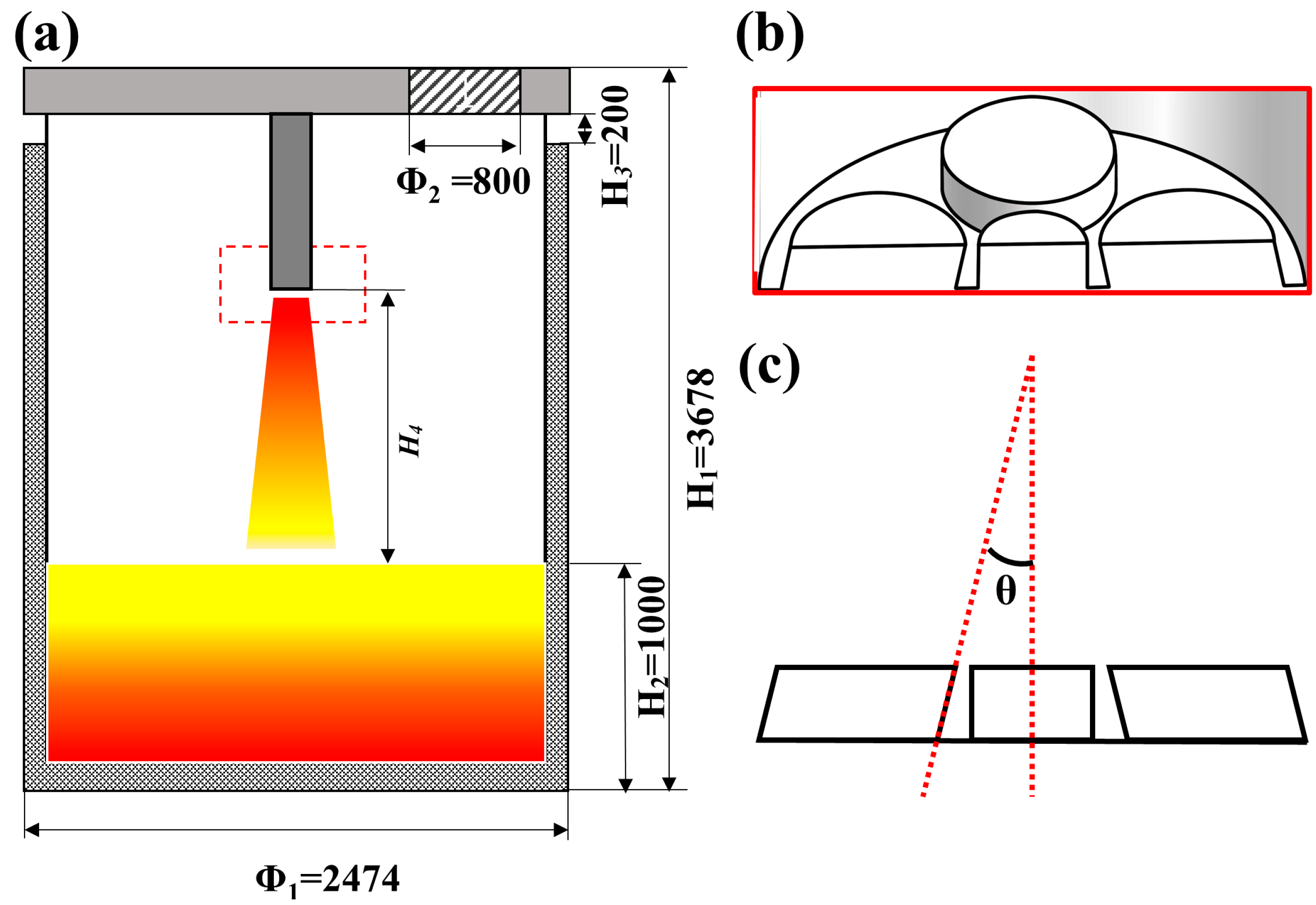
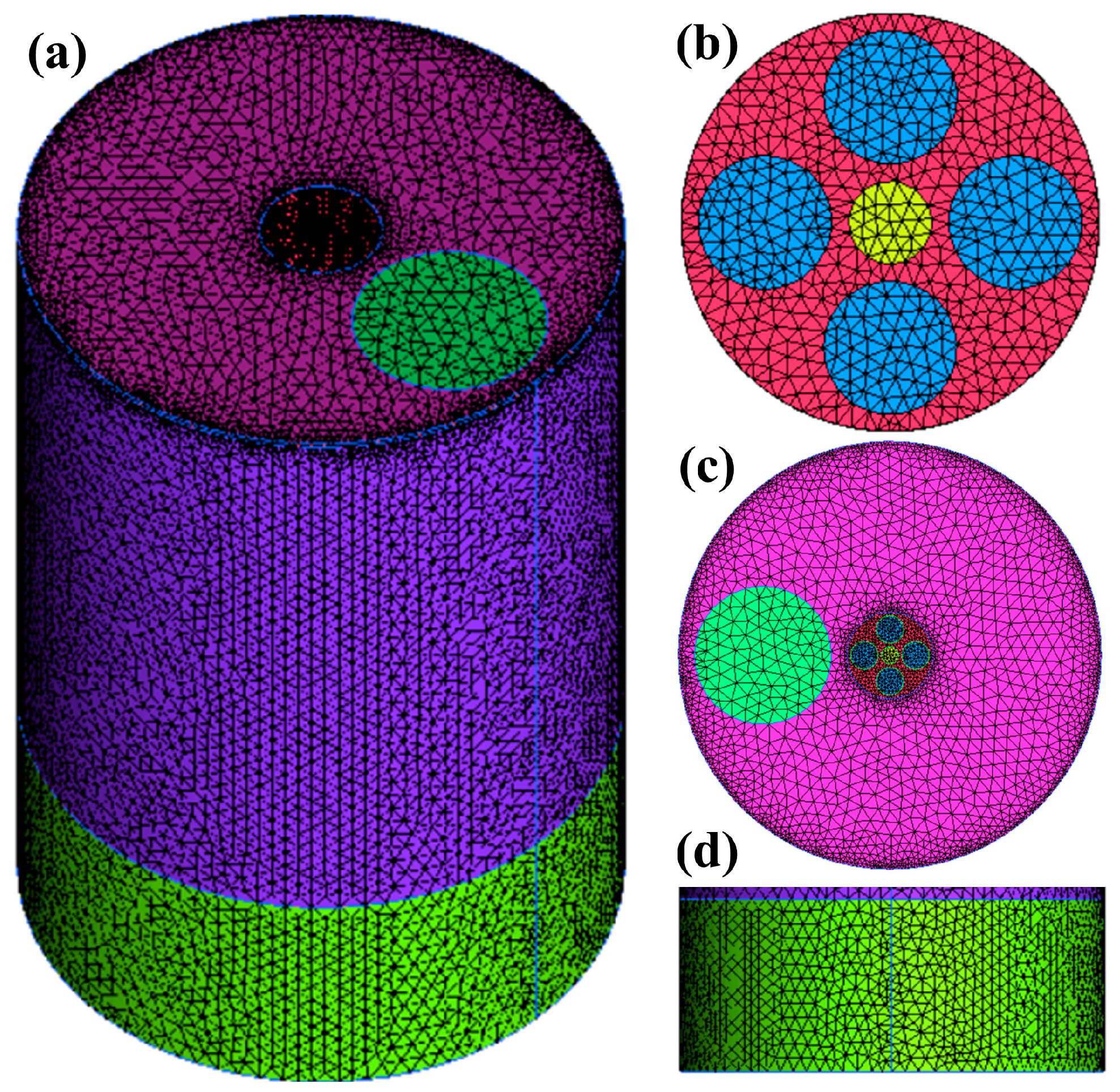
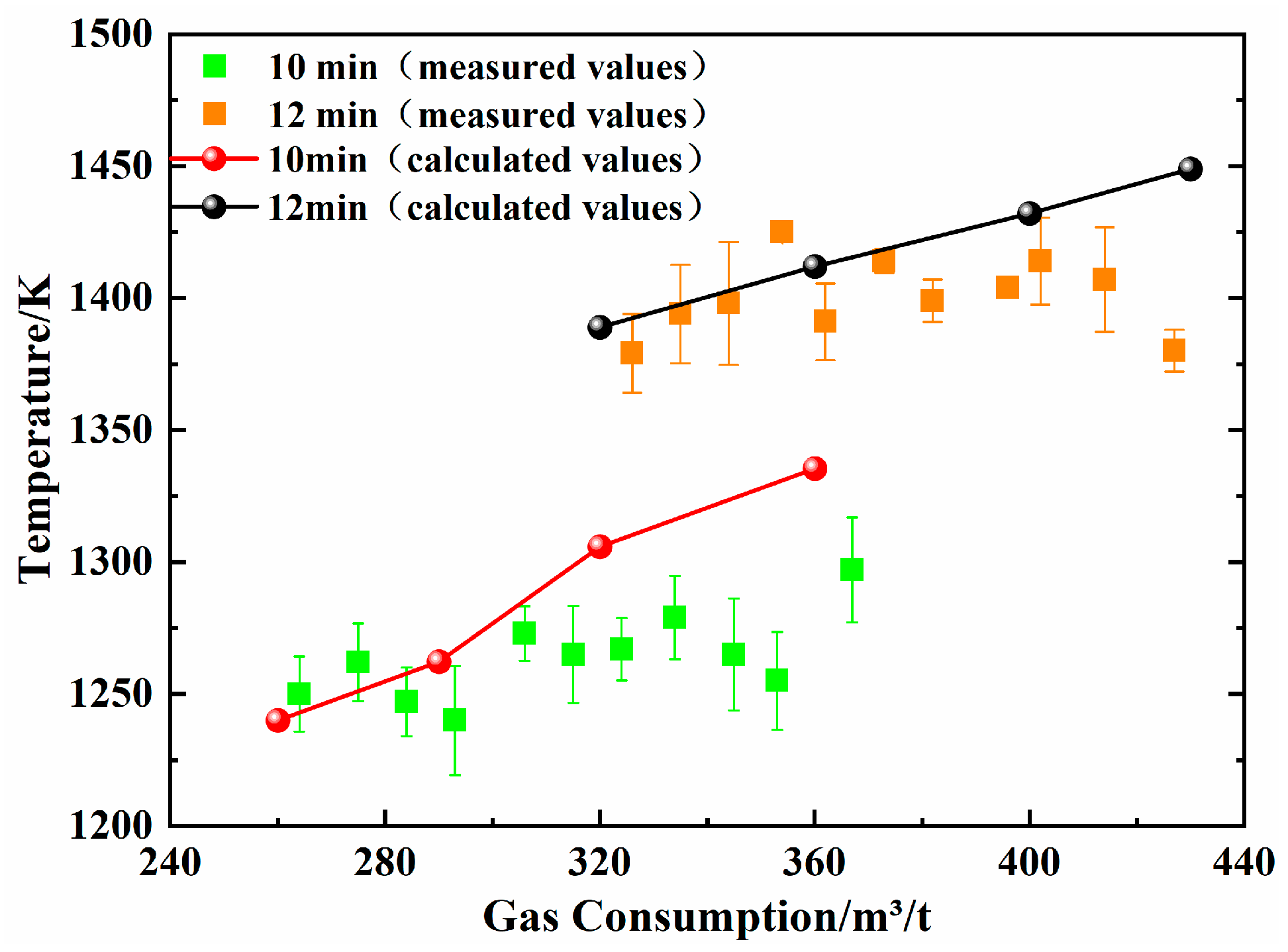

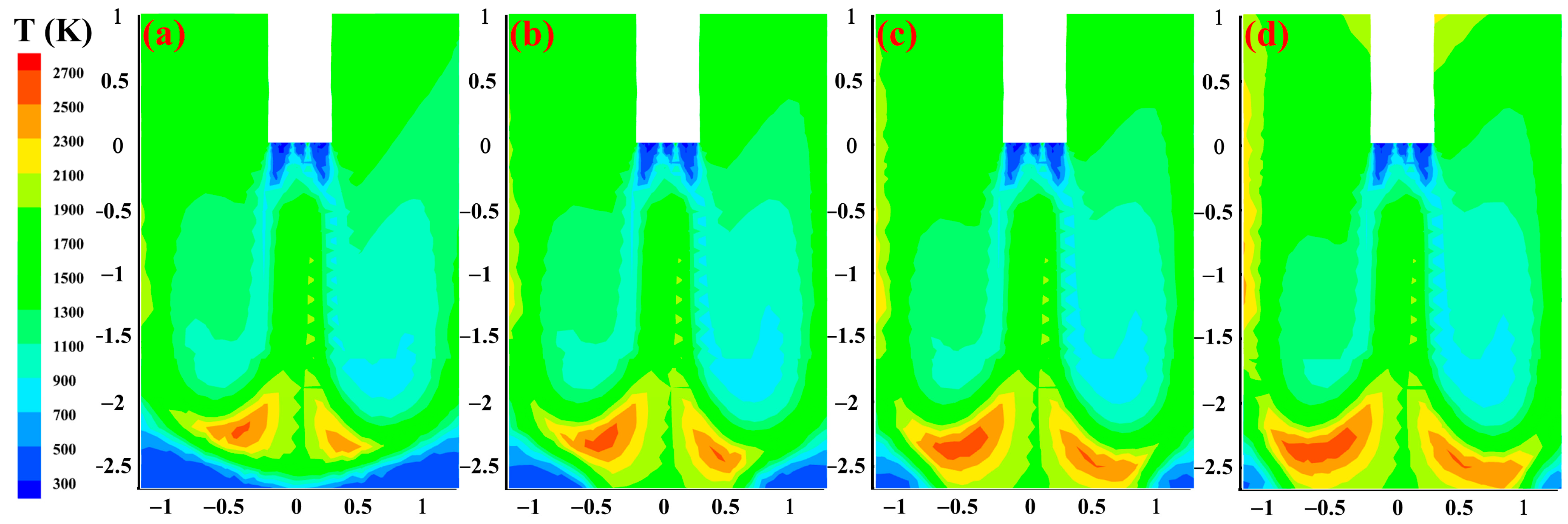

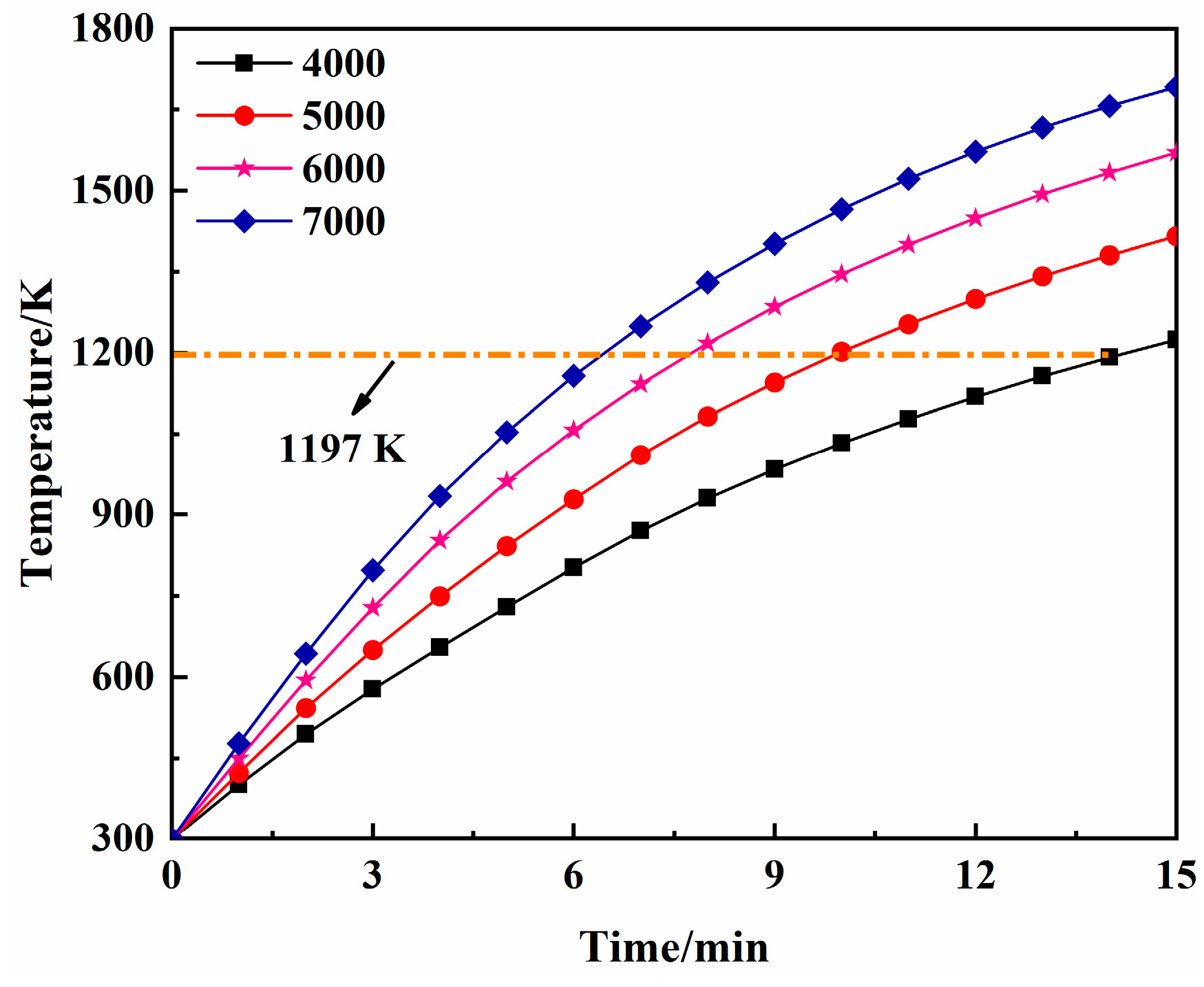


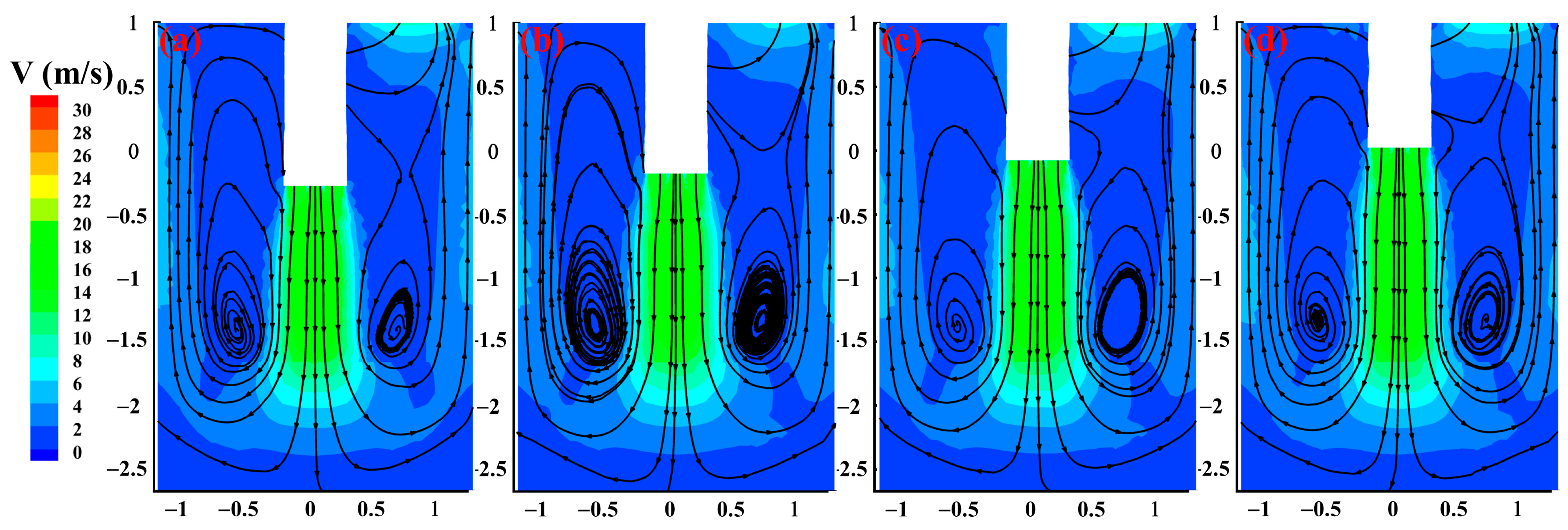
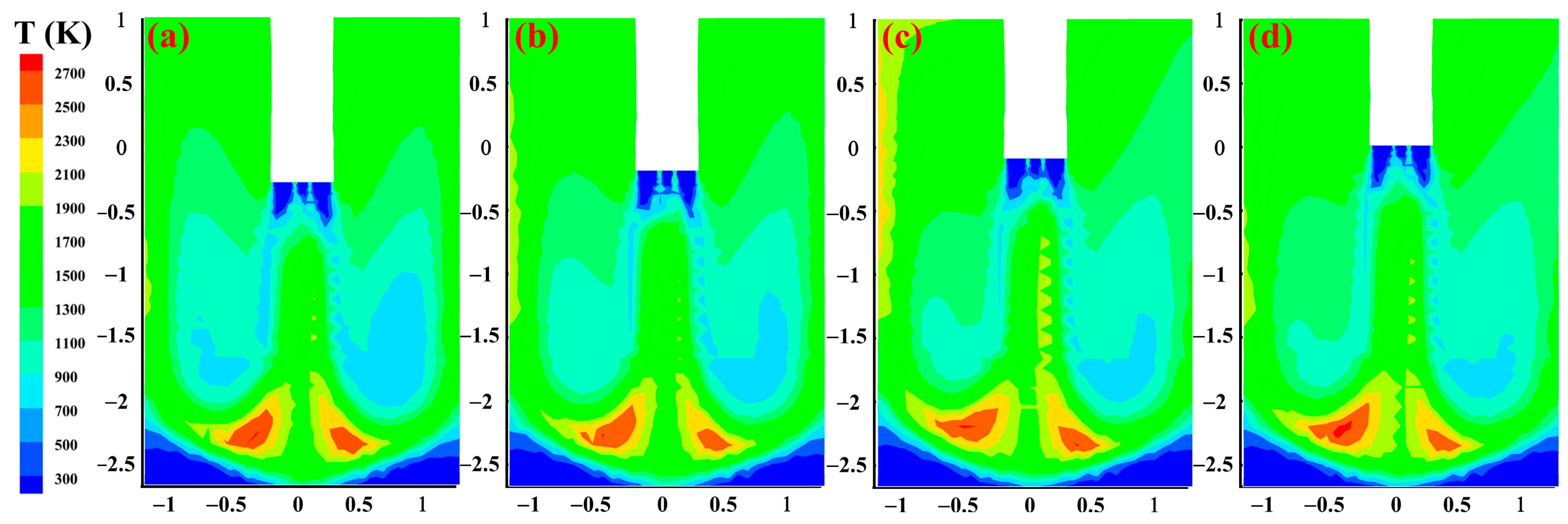






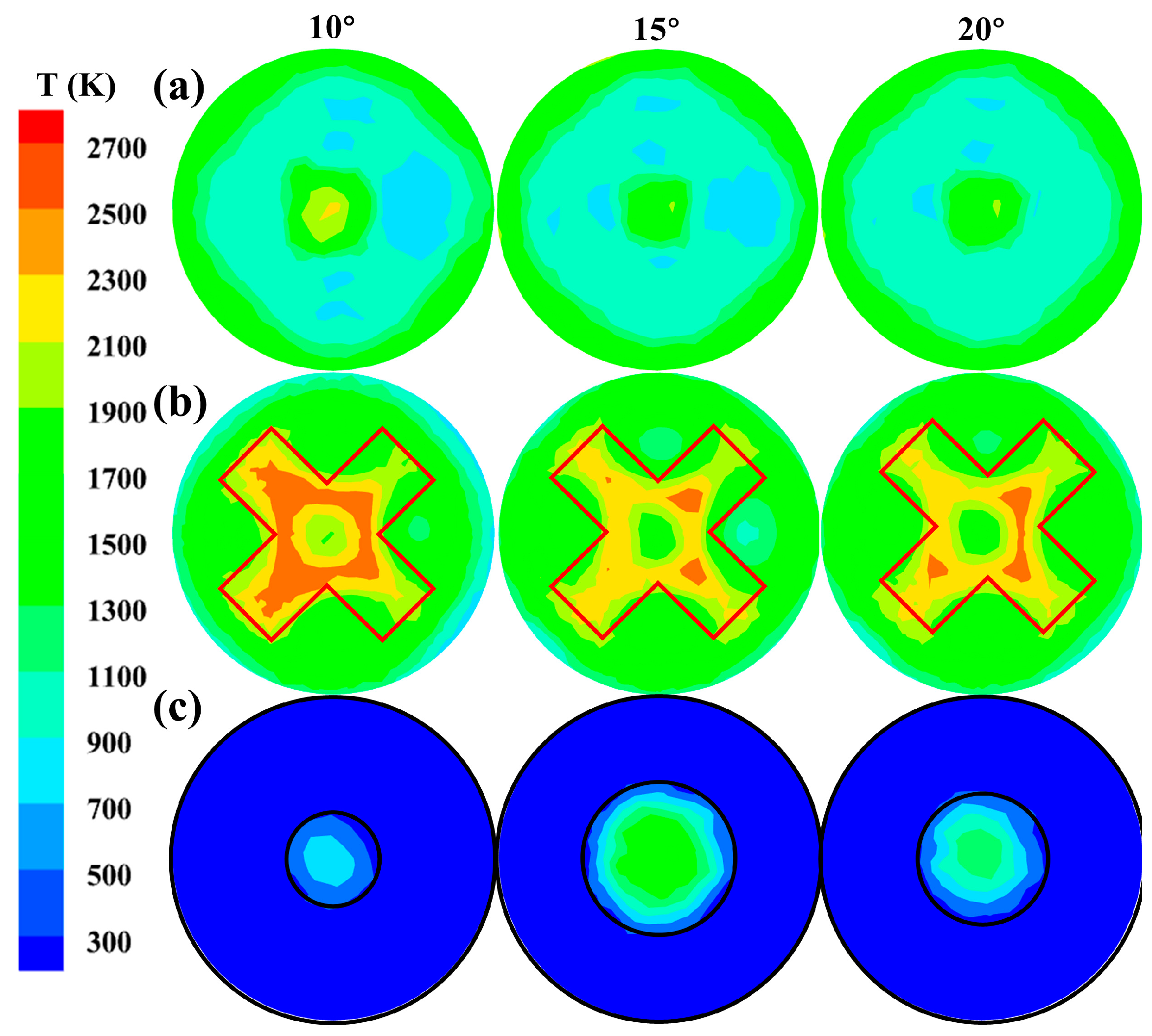
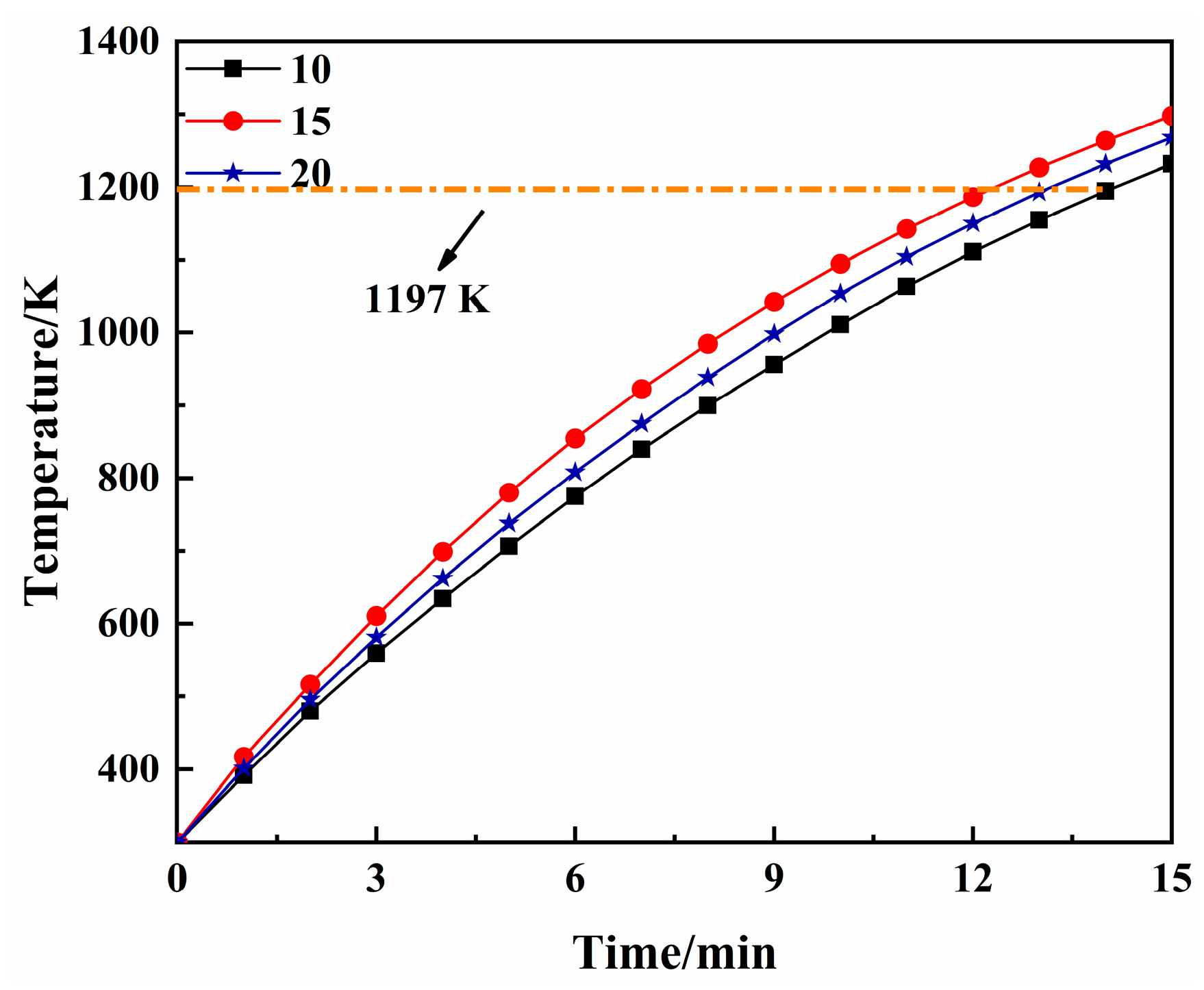


| Stage | Gas Flow /(m³·h−1) | Lance Positions/mm | Angle/° | |
|---|---|---|---|---|
| Stage 1 | 4000 | 1378 | 0 | Case1 |
| 5000 | Case2 | |||
| 6000 | Case3 | |||
| 7000 | Case4 | |||
| Stage 2 | 5000 | 1378 | 0 | Case5 |
| 1478 | Case6 | |||
| 1578 | Case7 | |||
| 1678 | Case8 | |||
| Stage 3 | 5000 | 1378 | 10 | Case9 |
| CO | CO2 | O2 | N2 | H2 | |
|---|---|---|---|---|---|
| Mass fraction | 34.84 | 17.53 | 0.67 | 45.73 | 1.10 |
Disclaimer/Publisher’s Note: The statements, opinions and data contained in all publications are solely those of the individual author(s) and contributor(s) and not of MDPI and/or the editor(s). MDPI and/or the editor(s) disclaim responsibility for any injury to people or property resulting from any ideas, methods, instructions or products referred to in the content. |
© 2023 by the authors. Licensee MDPI, Basel, Switzerland. This article is an open access article distributed under the terms and conditions of the Creative Commons Attribution (CC BY) license (https://creativecommons.org/licenses/by/4.0/).
Share and Cite
Zhuang, S.; Zhan, D.; Wang, T.; Li, P.; Yang, Y. Influence of Oxy-Fuel Lance Parameters on the Scrap Pre-Heating Temperature in the Hot Metal Ladle. Metals 2023, 13, 847. https://doi.org/10.3390/met13050847
Zhuang S, Zhan D, Wang T, Li P, Yang Y. Influence of Oxy-Fuel Lance Parameters on the Scrap Pre-Heating Temperature in the Hot Metal Ladle. Metals. 2023; 13(5):847. https://doi.org/10.3390/met13050847
Chicago/Turabian StyleZhuang, Shenglei, Dongping Zhan, Taotao Wang, Peng Li, and Yongkun Yang. 2023. "Influence of Oxy-Fuel Lance Parameters on the Scrap Pre-Heating Temperature in the Hot Metal Ladle" Metals 13, no. 5: 847. https://doi.org/10.3390/met13050847




